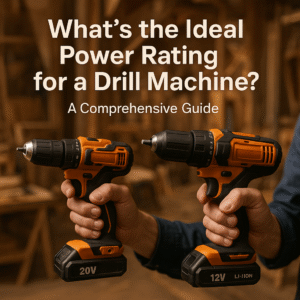What’s the Ideal Power Rating for a Drill Machine? A Comprehensive Guide
Ever stood in the tool aisle, staring at a wall of drills, completely baffled by the numbers? 12V, 20V MAX, 8 Amps, 550 in-lbs… what does it all mean? Choosing the right drill feels like a high-stakes test, but it doesn’t have to be. Getting the right power level isn’t about buying the biggest, baddest drill; it’s about matching the tool to your specific tasks.
Think of it like choosing a vehicle. You wouldn’t buy a massive semi-truck to commute to an office job, nor would you try to haul gravel in a sports car. Drills are the same. A lightweight drill is perfect for assembling furniture, but it will struggle to drill into masonry. A beastly hammer drill will blast through concrete with ease but is total overkill for hanging a picture frame.
This guide is your roadmap. We’ll break down all the technical jargon—Volts, Amps, Torque, and RPM—into plain English. By the end, you’ll be able to walk into any hardware store or browse online with the confidence of a seasoned pro, knowing exactly what power rating you need for your DIY projects, home renovations, or professional jobs.
De-mystifying the Numbers: What Do Drill Power Ratings Mean?
Before we can find the “ideal” power, we need to speak the language. Drill power is described using a few key metrics. Understanding them is the first step to making an informed choice.
Voltage (V): The Raw Potential
Voltage is the primary power indicator for cordless drills. It’s a measure of electrical potential—think of it as the raw horsepower of the drill’s engine. A higher voltage battery can deliver more power to the motor, allowing it to tackle tougher jobs.
- 12V Drills: These are the compact sports cars of the drill world. They’re lightweight, easy to handle in tight spaces, and perfect for light-duty tasks like driving screws, drilling small pilot holes, and assembling furniture.
- 18V or 20V MAX Drills: This is the most common and versatile category, like a reliable SUV. They offer a fantastic balance of power, weight, and runtime, making them suitable for everything from weekend DIY projects to serious home renovations. (Side note: 18V and 20V MAX are essentially the same; “20V MAX” refers to the initial voltage without a load, which drops to 18V during operation. It’s mostly marketing.)
- 36V, 40V MAX, or 60V MAX Drills: These are the heavy-duty trucks. They deliver power that rivals some corded models and are designed for professionals who need to drill large holes in dense materials consistently.
Amperage (Amps): The Endurance Fuel
Amperage, or Amps (A), is the primary power rating for corded drills. While voltage is the raw power, Amps measure the flow of electrical current. A higher amp rating means the drill can run under a heavy load for longer without overheating. It’s a measure of sustained power and durability.
- 4-6 Amps: A great range for a general-purpose corded drill for homeowners. It’s got enough muscle for most tasks around the house.
- 7-8 Amps: This is the sweet spot for serious DIYers and home renovators. These drills can handle tougher jobs like using larger drill bits or mixing thin-set mortar.
- 9+ Amps: You’re now in professional territory. These high-amp drills are built for constant, heavy-duty use on job sites, often found in hammer drills and specialty tools.
Deciding on your power source is the first major step. If you’re weighing the pros and cons of constant power versus ultimate portability, our detailed breakdown on which is better: corded or cordless drills is a must-read.
Torque: The Real-World Twisting Force
If voltage is horsepower, torque is the twisting force that gets the work done. Measured in inch-pounds (in-lbs) or Newton-meters (Nm), torque is arguably the most important indicator of a drill’s ability to drive screws and turn large bits. High torque is what prevents the drill from bogging down when you hit a tough spot in a piece of hardwood or try to sink a long screw.
Most modern drills have an adjustable clutch that allows you to set the maximum torque. This is crucial for preventing you from stripping screw heads or driving a screw too deep into a soft material. For driving fasteners, torque is king.
RPM (Revolutions Per Minute): The Speed Demon
RPM measures how fast the drill chuck spins. Many drills have a two-speed gearbox:
- Low Speed / High Torque: This setting (e.g., 0-450 RPM) is for driving screws. You need control and twisting force, not speed.
- High Speed / Low Torque: This setting (e.g., 0-1,700+ RPM) is for drilling holes. A faster spin clears material from the hole more effectively, leading to a cleaner, quicker result.
A good drill offers a balance. You need enough torque to do the work and enough speed to do it efficiently. Understanding the different types of drill machines can help clarify which models prioritize torque over speed, or vice-versa.
Quick Power Reference
Here’s the cheat sheet: For cordless, look at Voltage (V) for overall power and Torque (in-lbs) for twisting force. For corded, focus on Amps (A) for sustained performance.
Matching Drill Power to Your Projects
Now for the main event. Let’s connect these ratings to real-world tasks. We’ve broken it down into three common user profiles. Find the one that best describes you.
Category 1: The Light-Duty DIY Enthusiast
Who you are: You’re a homeowner or apartment dweller who needs a reliable tool for basic tasks. You’re assembling flat-pack furniture, hanging curtains and pictures, installing shelves on drywall, and maybe drilling the occasional pilot hole in soft wood.
Your Ideal Power Rating:
- Cordless: A 12V drill is your best friend. It’s lightweight, compact, and has more than enough power for these jobs. You don’t need a heavy, bulky tool.
- Corded: A 4 to 6 Amp drill will work, but a cordless model is far more convenient for these types of quick, mobile tasks.

Top Pick: Bosch PS31-2A 12V Max 3/8 in. Drill/Driver Kit
This is the quintessential 12V drill. It’s incredibly lightweight and compact, yet it delivers a surprising 265 in-lbs of torque. It’s perfect for getting into tight spaces like inside cabinets or under sinks. The kit comes with two batteries, a charger, and a carrying case, making it an excellent value for any homeowner.
Torque: 265 in-lbs
Weight: 2.14 lbs
Perfect For: Furniture assembly, cabinet installation, general household repairs.
Category 2: The Weekend Warrior / Home Renovator
Who you are: You’re comfortable with bigger projects. You’re building a deck, putting up a fence, drilling into hardwood or pressure-treated lumber, and using larger bits like spade bits or small hole saws. You need a versatile tool that won’t quit in the middle of a project.
Your Ideal Power Rating:
- Cordless: The 18V / 20V MAX platform is your domain. Look for a brushless model for better performance and battery life. A torque rating of 400-600 in-lbs is ideal.
- Corded: A 7 to 8 Amp drill provides unstoppable power for these tasks. It’s a great choice if you’re working in one spot (like a workshop) and tackling dense materials all day.

Top Pick: DEWALT 20V MAX Cordless Drill / Driver Kit (DCD771C2)
There’s a reason you see this yellow-and-black drill on so many job sites and in so many garages. It’s the gold standard for all-purpose performance. It’s powerful enough for serious projects but still compact and ergonomic. The high-speed transmission delivers two speed variations, making it perfect for both drilling and fastening.
RPM: 0-450 / 0-1,500
Chuck Size: 1/2-inch
Perfect For: Deck building, home renovations, general construction, and all-around DIY.
Category 3: The Heavy-Duty Pro / Serious Enthusiast
Who you are: You’re a professional contractor, a woodworker dealing with large bits, or a DIYer who needs to drill into concrete, brick, or masonry. Your projects demand maximum power and durability. “Good enough” isn’t in your vocabulary.
Your Ideal Power Rating:
- Cordless: A top-tier brushless 20V MAX (or higher) hammer drill is what you need. Look for torque ratings of 800 in-lbs or more. These tools are built to handle daily abuse.
- Corded: A 9 to 10+ Amp corded hammer drill is the king of raw power for masonry work. When you need to drill dozens of holes in a concrete foundation, you can’t beat the sustained performance of a corded model.
If you’re looking for a curated list of top performers in both cordless and corded categories, be sure to check out our guides on the best cordless drills and the best corded drills available today.

Top Cordless Pick: DEWALT 20V MAX XR Hammer Drill (DCD996B)
This is the next level of cordless power. The brushless motor is highly efficient, and its heavy-duty 1/2-inch ratcheting chuck provides superior bit-gripping strength. With three speed settings and a powerful hammer action, it can blast through concrete and masonry, yet it’s versatile enough for standard drilling and driving tasks. This is a professional-grade tool.
Max RPM: 2,000
BPM (Blows Per Minute): 38,250
Perfect For: Professional construction, drilling into concrete/brick, and any high-demand task.

Top Corded Pick: DEWALT DW511 1/2-Inch VSR Hammer Drill
When you need uncompromising power for drilling into hard materials, this corded hammer drill from DEWALT is a workhorse. Its 10-Amp motor provides high performance and overload protection. The dual-mode feature allows for easy switching between standard drilling and hammer drilling. It’s built tough for job site conditions and will not let you down.
RPM: 0-1,200 / 0-3,500
Chuck Size: 1/2-inch
Perfect For: Drilling into concrete slabs, brick walls, and steel fabrication.
Beyond the Big Numbers: Other Features That Affect Performance
The power rating is crucial, but it’s not the whole story. A few other features directly impact how that power translates into real-world performance.
- Brushed vs. Brushless Motors: This is a big one. Brushless motors are more modern, efficient, and powerful. They run cooler, extend the tool’s lifespan, and get more runtime out of a cordless battery. If your budget allows, always opt for brushless.
- Chuck Size: Drills come with either a 3/8-inch or 1/2-inch chuck. A 1/2-inch chuck can hold larger bits and is a sign of a more powerful, heavy-duty drill. Most 12V drills have a 3/8-inch chuck, while most 20V MAX models have a 1/2-inch chuck.
- Clutch Settings: The numbered collar behind the chuck is the clutch. It allows you to set the maximum torque. A higher number of settings (e.g., 20+1) gives you finer control, which is essential for delicate fastening jobs.
Once you have the right tool, it’s just as important to know how to use a drill machine safely and effectively to get the best results for your home improvement projects.
Frequently Asked Questions (FAQs)
Is a 12V drill powerful enough for drywall?
Absolutely. A 12V drill is more than powerful enough for drilling into drywall and driving drywall screws. Its light weight is actually an advantage here, as it reduces fatigue when you’re working overhead or for extended periods.
What’s the real difference between 18V and 20V MAX drills?
Mostly marketing. Both types of batteries operate at a nominal voltage of 18V. The “20V MAX” branding refers to the maximum initial voltage of the battery pack immediately after charging, without any load on it. As soon as you start using the drill, the voltage settles at 18V. For all practical purposes, they are in the same power class.
How many amps do I need for a corded drill?
For general home use, a 5-7 Amp drill is perfectly sufficient. If you plan on tackling more demanding tasks like using large hole saws or mixing materials, stepping up to an 8-10 Amp model is a wise investment.
Is more torque always better?
Not necessarily. While high torque is great for heavy-duty applications, too much torque can be a problem for delicate tasks. Using a high-torque drill to assemble particleboard furniture, for example, is a recipe for stripped screws and damaged wood. That’s why an adjustable clutch is so important—it lets you dial in the right amount of torque for the job.
Can I use a regular drill for concrete?
You can try, but you won’t get very far and you’ll likely burn out the motor. Drilling into concrete or masonry requires the specialized chipping action of a hammer drill. A hammer drill not only spins the bit but also punches it forward thousands of times per minute (BPM), pulverizing the material as it drills.
The Final Verdict: Your Ideal Power Is Personal
As we’ve seen, there is no single “best” power rating. The ideal power for a drill machine is entirely dependent on you and the work you plan to do. Don’t overbuy and get a tool that’s too heavy and powerful for your needs, and don’t underbuy and end up with a drill that constantly struggles.
Here’s the final takeaway:
- For light-duty tasks and maximum convenience, a 12V cordless drill is a fantastic choice.
- For all-around versatility and serious DIY, a 20V MAX brushless cordless drill is the undisputed champion.
- For unstoppable power and heavy-duty masonry work, a high-amp corded hammer drill is the right tool for the job.
By assessing your needs honestly, you can choose a drill that will not only get the job done but will also be a pleasure to use for years to come. Understanding the vast uses of a drill machine can also help you anticipate future projects and choose a tool with the versatility you’ll need down the road.


